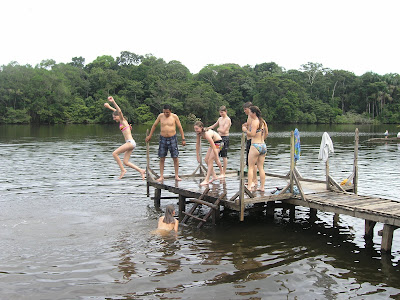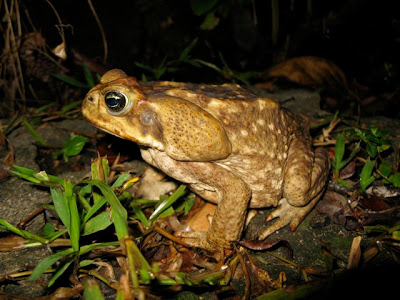


Although we have been getting up before 6:00 A.M. every morning, I sleep lightly, waking up every hour to check my alarm clock so that we don't oversleep. I am having battery issues and want to make certain not to miss our bus to Limon. My old school clock rings dutifully at 5:00 A.M; and we are downstairs by 5:30 A.M. pleased to see that the continental breakfast is already set out. I breakfast on cold Pinto de Gallo (rice, mixed with black beans; a Costa Rican specialty,) queso blanca, (soft white cheese,) and a sliver of melon. The coffee is not fully brewed but I drink a cup anyway, not certain if I will have another opportunity. We tuck two hardboiled eggs in our bags for a snack and catch a taxi to the bus station a few minutes away.
The one way ticket to Limon, on the Carribean Coast is just $6.00. The bus station is modern and the shiny blue tour bus with large clean windows, parked under the sign to Limon is realitively new. I am slightly disappointed; at the very least I am expecting rambunctious children, baskets of vegetables and a chicken or two. (I do not wish for pigs, in view of the current swine flu outbreak.) I grab a cup of cafe con leche and board the bus which leaves precisely at 6:30 A.M. It is quite full, we have assigned seats, and Tabra gives me the window. The city of San Jose fades quickly to countryside and we pass oceans of banana and coffee plantations and farmlands dotted with Brama cattle and calves. Many of the fences here are constructed of growing trees, strung together by barbed wire. The ingenious growing fences are as varied as the abundant diversity of plants. Palms of all kinds, flowering trees and bushes paint the landscape. As our bus descends from the highlands towards the Caribbean coast, the landscape changes to hillsides carpeted with antheriums, orchids and lush with ferns. The 2 1/2 hour bus trip goes quickly and soon we are in Limon.
As we disembark, several taxi drivers target us, one more persistent than the others. After a brief negotiation, we allow a man, with one blind eye, to take us to his taxi which turns out to be just his dilapidated car with a broken windshield. At this point, we might have changed our minds, but his persistence that he has a friend who can take us up river to Tortuguero gives me comfort and it isn't until we are near the port of Moin, that we make it clear that we already have reservations with the Tropical Wind for transport.
The port of Moin is minimal. There are a dozen open sided motor launches moored along side the dock, a crumbling concrete restroom facility with filthy toilets, and no where to buy so much as a bottle of water or an unhealthy snack. We each eat our hardboiled egg, a banana and ration our remaining water. We print our names and passport numbers onto a piece of notebook paper and pay our $60.00 for the round trip fare to Tortuguero and back. Tabra's Spanish is extremely helpful and she insists on a receipt for the return trip two days hence. Perhaps 20 tourists are waiting dock side on this gloriously sunny and mild morning.
There are only 7 passengers on our covered motor launch; two solemn young women backpackers from Germany, a young backpacking couple from Israel, the captains 9 year old daughter, wearing a crisp pink button down cotton shirt, and ourselves. The boat has 28 seats and with the luggage stowed at the back and more than ample room to sprawl out, we begin our upriver trip to Tortuguero. Along the first stretch of the river are restaurants and bungalows, colorfully painted with lush flowering gardens. The captain moors at a riverside checkpoint, presenting the limp piece of paper with our names and passport numbers, to a man in uniform. Further upriver we stop for gas, remaining in the boat while the captain refuels, the gasoline fumes lingering in the hot, humid air. A large green iguana is chased from the dock and sent splashing into the river and I wonder why this emerald beauty is not encouraged to make the rest stop his home, if only for the benefit of the incoming travelers. Once underway, the breeze cools us and we travel into paradise, cutting through the opaque greenish brown river, the jungle lush on either side, Our captain slows the boat to point out numerous birds; egrets, spoonbills, kingfishers, and snake birds. His English is impeccable, but his intent is to deliver us to Tortuguero, and we travel faster than I would like. I look back and see both of the German women asleep and wonder why they would bother to visit Tortuguero and sleep through this incredible jungle river trip. To me, it's as much about the journey as the destination. There are faster ways to get to Tortuguero, but I purposelessly choose this route so as to spend as much time on the river as possible. 5 years ago, Alisha, John and I made this trip, an unforgettable experience, which has lured me to return again. The captain spots a troupe of Howler Monkeys high in the tree tops and we watch for some minutes. My camera isn't good enough to capture their antics, but I'm delighted just to watch.
Two hours upriver, we stop for refreshments, a captive group of hungry travelers. The greasy fried chicken, runny beans and wilted cabbage salad is less than appealing, but we pay our $6.00, peel off the fried skin, and make do. The restaurant's location is a jungle paradise, but the restaurant itself is devoid of charm. Tabra and I talk about how easy it would be to make it inviting, both artistically and with a simple and healthy menu.
An hour later we arrive in Tortugero, dropping the 4 backpackers off on the shore at the center of the village. The afternoon is warm and humid and handsome young Caribbean men are gathered near the rivers edge, under the shade trees, leaning against upturned fishing boats. There is no formal dock or central square; just heavily trodden grass and dirt paths puddled with water from an earlier rain. The village has grown considerably since I was here 5 years ago and restaurants and cafes, line the rivers edge. We disembark a few docks up at Casa Marabella. The inn has expanded from just 4 rooms to 9 rooms and I have reserved one of the new upstairs river view rooms; $60 for a double including breakfast. The downstairs rooms are still $35 for a double, the same as we paid 5 years ago. Several wooden tables with chairs are arranged on the covered open deck facing onto the river and two guests sit reading and writing postcards. Our room is lovely and light, a solid bank of windows on two sides, up at tree level and overlooking the river. In this climate, the beds are made up with only sheets and our towels are folded in a fan shape across our respective beds. We take only a minute to settle in, anxious to explore the village. We step out of our tiny inn, directly into the village. Tortuguero is on the Caribbean side and the village is Caribbean in flavor; single story shops and houses, brightly painted and in disrepair. The ethnicity is a mixture of Spanish and Caribbean. There are no cars in the village, only a hard packed dirt walking path. Several gift and sundry shops are scattered along the few blocks of town, but there is nothing that a discerning tourist would want to buy as a souvenir. We peruse the restaurants and cafes, studying the respective menus and their ambiance and make a reservation at Miss Julies for dinner tonight.
Miss Julies restaurant is famous in Tortuguero, having been here in some form or another since the early 20th century. Alisha, John and I ate dinner here 5 years ago when the establishment was just eight tables in room adjoining Miss Julies home. Tonight we sit in a large dining room, windows all around and open to the balmy night air. The floor is a stylish ceramic tile and there are perhaps 18 wooden tables covered with bright cloths, the backs of the chairs simply carved. We decide on the river shrimp, but they have run out, so we order the fish fillet. By American standards, dinner is not expensive, about $12 including a glass of wine, but the meal is disappointing.
A tropical storm blows in and we fall sleep in our treetop room to the sound of torrential rain, thunder and flashes of lightening.


































